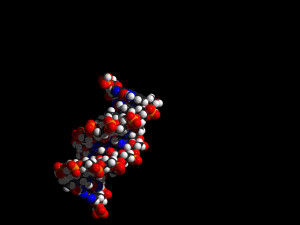By Sarah Alger
Our museum here at Massachusetts General Hospital is one not just about medical history, but also about modern-day innovation, and by extension, researchers grappling with today’s biomedical mysteries. One such mystery has to do with our fundamental understanding of genetics (I hope you’ll forgive the slight deviation).
Upon the first publication of the human genome in 2000, we learned that we have only about 20,000 genes (many fewer than scientists had anticipated); moreover, genes make up a mere 1.5% of the genome.
How can this be? What’s in the genome if not genes?
As we learned in high school biology, DNA prompts the creation of a complementary strand, called RNA, which does DNA’s bidding (making proteins). Yet this only happens with our 1.5% of the genome. With the remaining 98.5%, many of these mysterious pieces of DNA do generate RNA, but they don’t go on to create proteins.
 For a long time these swaths of the genome were dismissed as “junk.” However, researchers at Mass General and elsewhere are beginning to find that at least some expanses–called long noncoding RNA–have effects on human development and disease. Jeannie Lee, a molecular biologist at Mass General, found that it was a long noncoding RNA that is responsible for “silencing” one of a female’s two X chromosomes (were both to be active, genetic problems would arise). Other work has uncovered the importance of these RNA strands to the refinement of a fetus’s features.
For a long time these swaths of the genome were dismissed as “junk.” However, researchers at Mass General and elsewhere are beginning to find that at least some expanses–called long noncoding RNA–have effects on human development and disease. Jeannie Lee, a molecular biologist at Mass General, found that it was a long noncoding RNA that is responsible for “silencing” one of a female’s two X chromosomes (were both to be active, genetic problems would arise). Other work has uncovered the importance of these RNA strands to the refinement of a fetus’s features.
It is still unknown how much of these strands serve vital functions. Dubbed by some scientists “dark matter,” referring to unseen matter in the universe, much of it remains a mystery.
Our exhibit, drawn from Mass General’s Proto magazine (full story here), underscores just how rich but young the history of genetics is. At Mass General, a genetics unit was established in the early 1960s (largely for diagnosis, rather than fundamental findings), and the draft publication of the genome was just 16 years ago.
